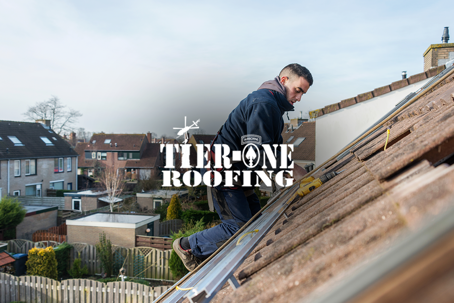Why Your Roof Sounds Different in Summer (And When to Worry About It)
On a hot summer day, your home is quiet. Then you hear it: a loud pop from above. Later, as the evening cools, there’s a creak or a crack that makes you pause and look up. Is your roof failing? Or is it just reacting to the Oklahoma summer heat?
At Tier-One Roofing, we get these calls every year. Homeowners worry their roof is falling apart because it suddenly sounds different in July than it did in February. Sometimes those sounds are harmless. Sometimes they’re a warning sign.
Here’s how to tell the difference, why it happens, and what to do next.
What Causes Roof Noises in Summer?
Roofs aren’t static—they’re made of materials that expand and contract based on temperature. Summer heat accelerates these changes, and your ears pick up the results.
Common causes include:
Thermal Expansion: Heat causes roofing materials, nails, and decking to expand. As temperatures drop at night, they contract. This can create popping or creaking sounds.
Attic Heat: Poor ventilation can make attic spaces excessively hot, sometimes topping 150°F. That heat stress can cause wood components to shift slightly, creating audible noise.
Moisture Shifts: If a roof or attic isn’t sealed or ventilated properly, moisture can cause swelling in decking or trusses. In summer, this can add to noise as materials dry out.
Structural Load Changes: Gutters clogged with summer debris or heavy HVAC units in the attic can shift under heat stress, leading to occasional creaks.
Rodents or Wildlife: Occasionally, noises are more than just thermal. Birds, squirrels, or wasps may be making themselves at home.
Tier-One Roofing checks for all these factors during an inspection so you know whether it’s harmless or needs fixing.
What’s Considered “Normal” Summer Roof Noise?
Some noises are simply your roof adjusting to extreme weather. If you hear:
Soft creaks as the day cools
Occasional single pops (often nails shifting slightly)
Light ticking near vents or soffits
…these are typically harmless, especially in older homes where materials have more play.
But it’s when noises are frequent, loud, or sudden that you should pay attention.
Noises That Are Red Flags
Call Tier-One Roofing immediately if you notice:
Repetitive popping in the same spot: Could mean fasteners are loosening or decking is warping.
Creaking combined with sagging or visible roof dips: May signal structural issues.
Scratching or scurrying noises: Likely pests, which can damage insulation and wiring.
Loud cracks during high heat days: Could indicate materials separating.
Your roof shouldn’t sound like a fireworks show or a drumline. If it does, something’s wrong.
The Role of Ventilation in Summer Roof Noise
Oklahoma summers are brutal. Without proper ventilation, your attic becomes a pressure cooker. That heat:
Warps wood and decking
Softens asphalt shingles
Increases moisture accumulation
Exaggerates material movement (and noise)
Tier-One Roofing includes ventilation checks in every roof inspection because controlling attic temperature isn’t just about comfort—it’s about roof longevity and safety.
How Noise Links to Roof Damage
Sometimes those pops and cracks aren’t just expansion—they’re warning signs:
Loose fasteners: Heat cycles can back nails out, creating pathways for water.
Decking movement: Warped or swollen wood can compromise structural integrity.
Shingle lift: Heat can cause shingles to separate from adhesives, increasing storm vulnerability.
Hidden leaks: Water finds those gaps created by movement, causing long-term damage.
Ignoring noise because “it’s probably nothing” can turn a small fix into a major repair.
Tier-One Roofing specializes in finding the root cause before it costs you.
What to Do When You Hear Strange Roof Noises
Stay calm: Most summer noises aren’t emergencies.
Look for visual changes: Check for missing shingles, sagging areas, or water spots inside.
Note the timing: When do the noises happen—hot afternoons, cool evenings, during wind?
Call for an inspection: Let professionals determine if it’s harmless or serious.
We offer free inspections and same-day reporting so you don’t have to guess.
Why Tier-One Roofing Is the Right Call
When your roof talks, you need someone who listens—and understands what it’s saying. We’re veteran-owned, community-rooted, and we approach every home like it’s our own.
Here’s what you get with Tier-One:
Thorough roof and attic inspection
Photo documentation and easy-to-understand reports
Honest answers (no upsell, no scare tactics)
Solutions designed for Oklahoma’s unique climate
A team that will still be here years from now to stand behind our work
We know roof noise can be unnerving. Our job is to give you peace of mind and fix problems before they become emergencies.
Don’t Ignore What Your Roof Is Telling You
A roof that suddenly sounds different is worth paying attention to. Maybe it’s just heat expansion. Maybe it’s something bigger. The only way to know is to look.
Call Tier-One Roofing today for a free roof and attic inspection. We’ll find out why your roof sounds different, show you exactly what’s happening, and give you clear next steps.
Because your home should feel safe, not uncertain. And if your roof is trying to tell you something, we’re here to listen—and fix it.

